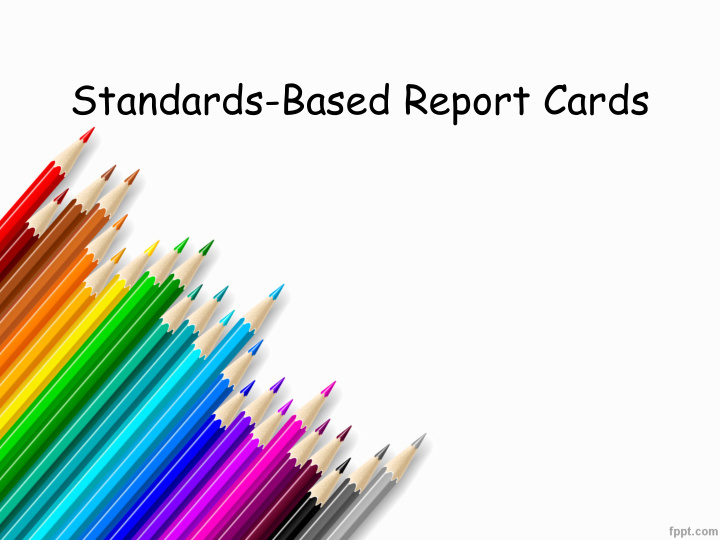



Standards-Based Report Cards
“ Why…would anyone want to change current grading practices?” “The answer is quite simple: grades are so imprecise that they are almost meaningless.” --Robert Marzano
“Grading as it has been done traditionally promotes a culture of point accumulation not learning, encourages competition not collaboration, often focuses on activities not results…and only involves assessment OF learning because everything students do gets a score and every score ends up in the grade book.” ---Ken O’Connor
Principles of Grading Reporting should be based on clearly specified learning goals and performance standards Evidence used for grading should be valid Grading should be based on established criteria, not on arbitrary norms Not everything should be included in grades Avoid grading based on averages Focus on achievement and report other factors separately
What is a Standards-Based Report Card? It reports a child’s progress toward meeting state and district standards in areas of content and performance. It gives specific information on a student’s level of proficiency on a given standard.
Standards-Based Reporting System The purpose of the reporting system is to report separately: Student achievement based on content standards with end of the year expectations Student social development and work habits
Standards-Based Grading A focus on mastering content “standards” instead of accumulating points A report of what students know and are able to do A balance of formative and summative assessments (mounting evidence) A record keeping system that informs instruction A system that encourages student reflection and responsibility for learning
Benefits of a Standards- Based Reporting System Measure what a student should know and be able to do by the end of each grade in each learning area. Identify the concepts and skills in each learning area based on these standards Indicate what skills students have mastered, as well as their strengths and areas for growth. Progress will be reported for each of the grade level standards identified rather than a single grade for each subject area. Students, parents, and teachers work together toward shared goals to ensure that students make progress each year. All teachers across the District will have the same expectations and common understandings about learning targets at each grade level and be able to build student knowledge based on student mastery of the previous year’s
What is Not Included in Standards- Based Grades: Effort Attendance Participation Citizenship Attitude Extra Credit Behavior Group Work Homework Anything that doesn’t relate to a stand ard
Student’s Name: John Smith Question Standard Question Standard 1 5.OA.1 Correct 11 5.NBT.2 Correct 2 5.OA.2 Correct 12 5.NBT.5 Correct 3 5.NBT.5 Correct 13 5.OA.2 Correct 4 5.NBT.6 Incorrect 14 5.OA.1 Correct 5 5.OA.2 Correct 15 5.NBT.1 Correct 6 5.OA.2 Correct 16 5.OA.6 Correct 7 5.NBT.6 Correct 17 5.OA.1 Correct 8 5.NBT.1 Correct 18 5.NBT.1 Correct 9 5.NBT.6 Incorrect 19 5.NBT.6 Incorrect 10 5.OA.6 Correct 20 5.OA.1 Correct Student Test Average 85% - B
Student’s Name: John Smith Question Standard Question Standard 1 5.OA.1 Correct 11 5.NBT.2 Correct 2 5.OA.2 Correct 12 5.NBT.5 Correct 3 5.NBT.5 Correct 13 5.OA.2 Correct 4 5.NBT.6 Incorrect 14 5.OA.1 Correct 5 5.OA.2 Correct 15 5.NBT.1 Correct 6 5.OA.2 Correct 16 5.OA.6 Correct 7 5.NBT.6 Correct 17 5.OA.1 Correct 8 5.NBT.1 Correct 18 5.NBT.1 Correct 9 5.NBT.6 Incorrect 19 5.NBT.6 Incorrect 10 5.OA.6 Correct 20 5.OA.1 Correct Standards-Based Approach John is meeting expectations for all standards except 5.NBT.6. John needs additional instruction and practice to be meeting expectations on standard 5.NBT.6
Proficiency Levels • ES (Exceeds Standard) = Student is consistently exceeding the standard for the grade level. Student grasps, applies, and independently extends key concepts, processes, and skills. • MS (Meets Standard) = Student is meeting the standard. Demonstrates proficiency and with limited errors, grasps and applies concepts, processes, and skills. • AS (Approaching Standard) = Student is making progress towards the standard for the grade level. The student is beginning to grasp and apply key concepts, processes, and skills. • NS (Needs Support) = Student is making minimal progress towards the standard for the grade level. The student is working below grade level. Improvement is needed.
Needs Support
Approaching Standards
Meets Standards
Exceeds Standards
Schedule of Marking Periods Progress Report - October 19, 2016 * First Marking Period – December 19, 2016 Progress Report – February 1, 2017 Second Marking Period – March 15, 2017 Progress Report – May 4, 2017 Third Marking Period – June 22, 2017 *Paper copy only for students who are not performing well at this point in the marking period.
How do teachers determine every child’s progress level? The standard based report card progress levels are based on student performance on specific tasks and assessments, which are tied to the learning standards. Teachers will use a rubric to determine each child’s performance. Comprehensive rubrics are used to describe the indicator levels on the report card and will be available online at the district website.
Questions???? This presentation along with the rubrics, report cards and handbook will be available on the district website
Remember… it doesn’t matter where the child starts, it’s where he or she finishes!
Recommend
More recommend